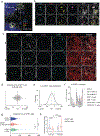Spatial microniches of IL-2 combine with IL-10 to drive lung migratory TH2 cells in response to inhaled allergen
- PMID: 39394532
- PMCID: PMC11934206
- DOI: 10.1038/s41590-024-01986-8
Spatial microniches of IL-2 combine with IL-10 to drive lung migratory TH2 cells in response to inhaled allergen
Abstract
The mechanisms that guide T helper 2 (TH2) cell differentiation in barrier tissues are unclear. Here we describe the molecular pathways driving allergen-specific TH2 cells using temporal, spatial and single-cell transcriptomic tracking of house dust mite-specific T cells in mice. Differentiation and migration of lung allergen-specific TH2 cells requires early expression of the transcriptional repressor Blimp-1. Loss of Blimp-1 during priming in the lymph node ablated the formation of TH2 cells in the lung, indicating early Blimp-1 promotes TH2 cells with migratory capability. IL-2/STAT5 signals and autocrine/paracrine IL-10 from house dust mite-specific T cells were essential for Blimp-1 and subsequent GATA3 upregulation through repression of Bcl6 and Bach2. Spatial microniches of IL-2 in the lymph node supported the earliest Blimp-1+TH2 cells, demonstrating lymph node localization is a driver of TH2 initiation. Our findings identify an early requirement for IL-2-mediated spatial microniches that integrate with allergen-driven IL-10 from responding T cells to drive allergic asthma.
© 2024. The Author(s), under exclusive licence to Springer Nature America, Inc.
Conflict of interest statement
Competing interests
The authors declare no competing interests.
Figures
















References
MeSH terms
Substances
Grants and funding
- DP2AI164325/U.S. Department of Health & Human Services | NIH | National Institute of Allergy and Infectious Diseases (NIAID)
- AI156093/U.S. Department of Health & Human Services | NIH | National Institute of Allergy and Infectious Diseases (NIAID)
- DP2 AI164325/AI/NIAID NIH HHS/United States
- R01 AI153104/AI/NIAID NIH HHS/United States
- AI153104/U.S. Department of Health & Human Services | NIH | National Institute of Allergy and Infectious Diseases (NIAID)
LinkOut - more resources
Full Text Sources
Molecular Biology Databases
Miscellaneous

